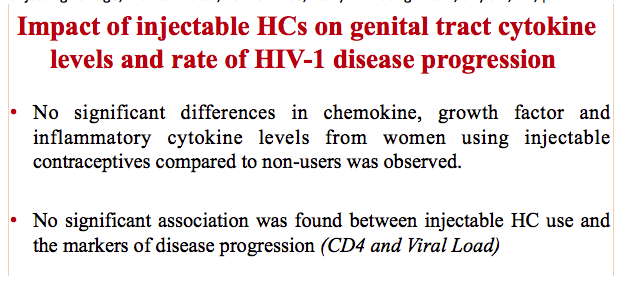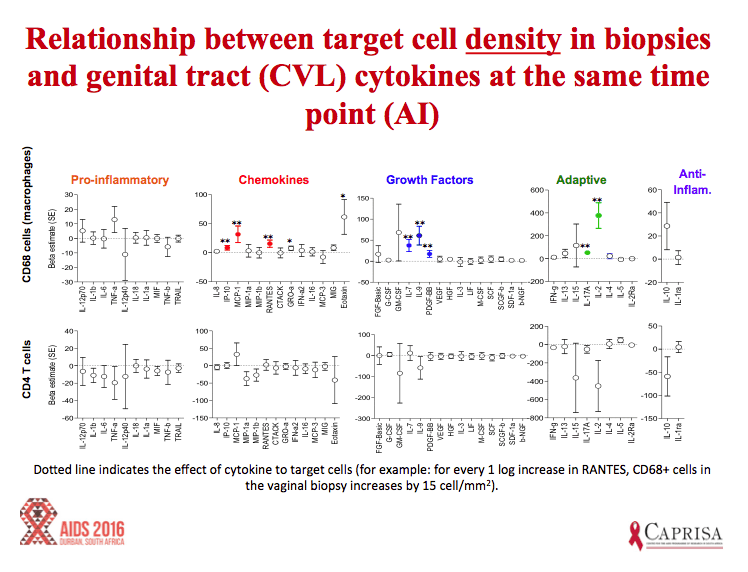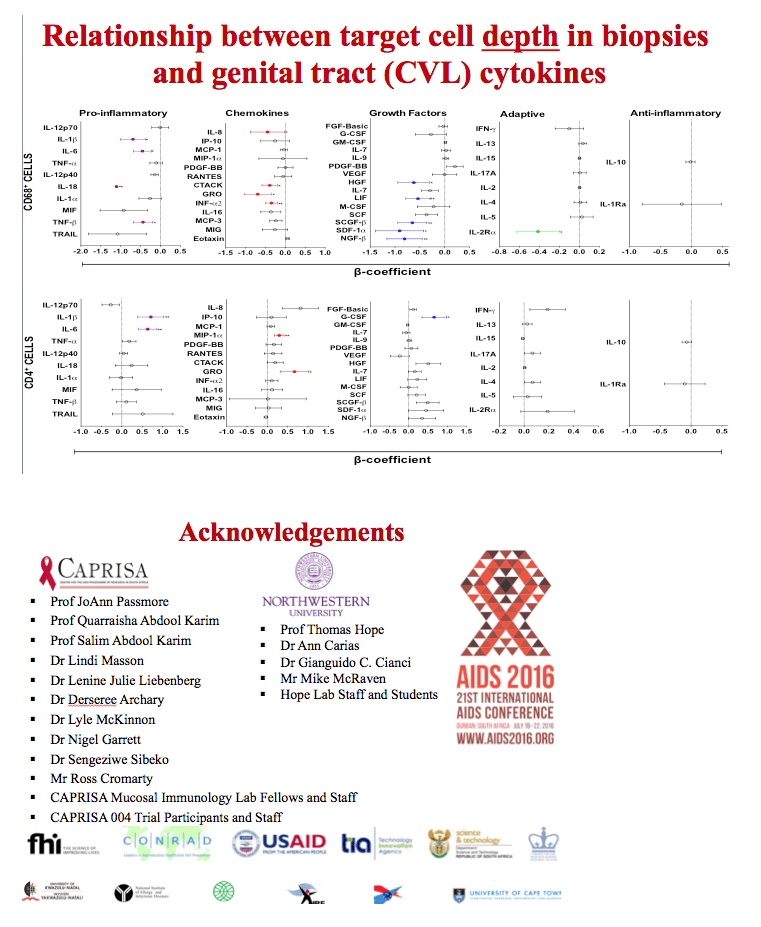 |
 |
 |
| |
Effect of injectable hormonal contraceptives on vaginal epithelium thickness
and genital HIV target cell density in women recently infected with HIV
|
| |
| |
See the wwebcast here
Reported by Jules Levin
Durban 2016 July 18-22
Presenter
Sinaye Ngcapu
Authors
S. Ngcapu1, A.M. Carias2, L.J. Liebenberg1, L. Werner1, G.C. Cianci2, M. McRaven2, S. Sibeko3, N.J. Garrett1, J.-M. Kriek4, L.R. McKinnon1, S. Abdool Karim1,5, Q. Abdool Karim1,5, J.-A.S. Passmore1,4,6, T.J. Hope2
Institutions
1Centre for the AIDS Programme of Research in South Africa (CAPRISA), Durban, South Africa, 2Northwestern University, Chicago, United States, 3Oxford University, London, United States, 4Institute of Infectious Diseases and Molecular Medicine, University of Cape Town Medical School, Cape Town, South Africa, 5Columbia University, Department of Epidemiology, Mailman School of Public Health, New York, United States, 6National Health Laboratory Service, Cape Town, South Africa
from Jules: is it possible higher CD4 levels - Women using injectable HC users had increased frequencies of CD4+ T cells in their vaginal stratified epithelium than those not using injectable HCs - leads to increased risk of HIV because CD4s attract HIV infection.


Background: Vaginal epithelial thinning and/or increased density of mucosal HIV-1 target cells are possible mechanisms by which injectable hormonal contraceptives (HCs) may increase risk for HIV-1 infection in HIV-1 negative women and the risk of her transmitting to her partner if infected. Here, the influence of injectable HCs on genital epithelial thickness, mucosal HIV-1 target cell density and depth in women with acute HIV infection was investigated.
Methods: CD4+ T cell and CD68+ macrophage density, both target cells for HIV infection, was measured by immunofluorescent staining in vaginal tissue biopsies from acutely-infected women who were either using injectable HCs or not using contraception. Concentrations of 48 cytokines measured in cervico-vaginal lavage (CVL). Blood CD4 counts and plasma viral loads were performed during acute infection and 12 months post-infection.
Results: Vaginal epithelial thickness was similar in women using injectable HCs compared to non-injectable HC users. The frequency of CD4+ T cells in the vaginal squamous epithelium of injectable HC users was significantly higher than non-injectable HC users (p=0.028). CD68+ macrophage cell density did not differ between women using injectable HCs and those not using injectable HCs, although macrophages were closer to the vaginal luminal surface in injectable HC users than those not using HCs (p=0.021). Furthermore, the frequency of mucosal CD68+ macrophages during the acute infection were positively associated with the concentration of the RANTES (beta coefficient (β)=0.779, p=0.024), MCP-1 (β=0.453, p=0.041), IP-10 (β=0.568, p=0.042), IL-7 (β=1.332, p=0.018), IL-9 (β=0.336, p=0.015), and IL-17 (β=1.058, p=0.007) in CVL, after adjusting for multiple comparisons.
Conclusions: Women using injectable HC users had increased frequencies of CD4+ T cells in their vaginal stratified epithelium than those not using injectable HCs. CD68+ macrophages correlated with a broad panel of mucosal cytokines. This study provides valuable insight into possible underlying mechanisms by which genital inflammation may increase HIV-1 risk and subsequent clinical phenotypes during HIV-1 disease course, such as viral set point.


⋅HIV-1 infected women using injectable HCs had significantly higher numbers of CD4+ T cells within the vaginal squamous epithelium than women using no or non-injectable HCs (p=0.028), after adjusting for age, condom use, study arm, marital status, plasma viral load, any STIs or BV.
⋅These high CD4 levels cannot be attributed to injectable HCs only, remember these women were already HIV infected

⋅CD4+ cells were a median distance of 136 µm from the vaginal lumen, with depth ranging from 59 - 297 µm.
⋅Vaginal CD4+ target cell depth did not differ between acutely HIV-1 infected women using injectable HCs compared to those not using or using non-injectable HCs
⋅In contrast to the CD4+ target cells, CD68+ macrophages were closer to the lumen in women using injectable HC compared to non-injectable HC users
⋅According to Carias et al. (2013), HIV-1 can breach the 10 - 20 μm thick layer of columnar epithelial and migrate to depths of 50 μm (which was the physical limit of the field microscope used) within the epithelium to reach the underlying target cells

⋅We also assessed the influence of injectable HC use on the rate of HIV-1 disease progression, disease progression was measured by plasma viral loads at 12 months post-infection and blood CD4 decline <350 cell/µl after 6 months post infection (at two consecutive visits).
⋅No significant association was found between injectable HC use and these markers of disease progression, after adjusting for age, marital status, condom use, study arm assignment, any STI, BV, plasma viral load.

⋅Of the 42 growth factors and cytokines measured, 6 were associated with higher frequencies of CD68+ macrophages, after adjusting for age, marital status, condom use, injectable hormonal contraceptive use, study arm, any STI, BV and plasma viral load.
⋅No association was found between any of the CVL cytokines measured and vaginal CD4+ T cell densities

⋅The depth of CD68+ target cells were associated negatively with inflammatory cytokines, chemokines and growth factors
⋅The negative correlation between the CD68+ macrophage density and genital cytokines suggests that these cells were further away from the vaginal lumen and likely migrating away to the lymph nodes for antigen presentation and subsequent initiation of humoral immunity
⋅depth of CD4+ target cells in the vaginal epithelium was positively associated with chemokines and inflammatory cytokines
⋅BUT Unlike CD68+ cells, this finding suggests that CD4+ cells are closer to the vaginal lumen in women with the highest vaginal lumen concentrations of pro-inflammaorty cytokines.

|
| |
|
 |
 |
|
|